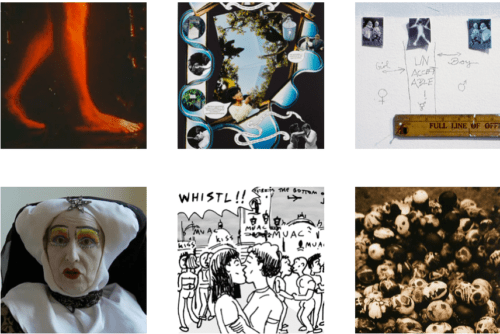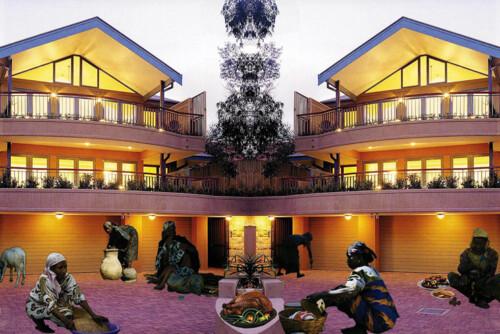The censoring of David Wojnarowicz’s video “Fire in my Belly” at the Smithsonian portraiture show Hide/Seek last year, under pressure from the radical religious right, reminds us that intermingling the sexuality and materiality of bodies with the transcendental concepts and questions of spirituality and religion can still shock. But as Janet Jakobsen queries in the Afterword to this special issue, just what is it about this alliance, in many ways so pedestrian and central to everyday life, as well as contemporary human experience, that creates such controversy?
The staying power of moral panic over the intersection between body and religion, religion and sexuality, invokes the famous culture wars ignited in 1980s: from Wojnarowicz’s early collages, Andres Serrano’s photograph Piss Christ, and Robert Mapplethorpe’s erotic photographs of black men that inflamed those on both the left and right, to Chris Ofili’s The Holy Virgin Mary made with elephant dung, a sign of sacred fertility in his native Nigeria, which caused so much controversy at the Brooklyn Museum’s Sensation show in 1999. These controversies did more than polarize; they also led to drastic cuts in public funding for the arts that are still with us today. And so is the censoring of artwork that engages the overlaps of bodily and spiritual life. One could be forgiven for desiring a little “difference” in this repetition. To this end, we have made Wojnarowicz’s censored video available so viewers can make their own assessment, largely impossible for previous, pre-Internet controversies.
The Catholic League, central to recent culture war protests against federal funding for the arts, and a key player in the censorship of Wojnarowicz’s video and Ofili’s artwork, defines its mission as one of defending against “anti-Catholicism.” The latter is defined on its own terms, however, with little resemblance to the historical, nativist anti-Catholicism against working-class Catholic immigrants in the 19th and early 20th century, nativism more similar to the oppression against today’s Latina/o immigrants than any supposed defamations against the Church. For the Catholic League, by contrast, “anti-Catholics” are defined as anyone, including progressive Catholics, who disagree with the hierarchical principle of papal infallibility or the conservative, rightward shift of the Vatican, anyone who dares to invoke the principle of the “people’s church” or who points out the increasing abrogation of the democratic reforms of Vatican II. Yet, the ludicrousness of attempts to censor and exclude the body and sexuality in religious representations, including art dear to the Catholic tradition, is palpable. No matter that all these artists say their work is meant to open up and expand reflection on religion and suffering, rather than sacrilege, as even Sister Wendy, the Catholic art critic, agrees. Far from controversial or cutting edge, the entire history of art (Christian art, especially) evidences the need to visualize the invisible, and the use of bodies to visually manifest idea(l)s beyond them. Michelango’s fresco on the Sistine Chapel is centered on the image of Adam’s naked body touching God’s own, which symbolizes creation. Bernini’s Ecstacy of St. Theresa in the Santa Maria della Vittoria in Rome shows the saint in the throes of ecstasy—ecstasy being used here as a sign of her holiness. And the entire array of depictions of Jesus Christ on the cross makes use of his sensuality to convey both his holiness and human suffering.
The videos, films and artwork in this section seek to re-insert the body back into religious imagery, as well as create space for those typically excluded. Fig Trees’ attempts to (re)appropriate and queer religious imagery, seeking a way to celebrate queer memory—without memorializing away insights about struggle in AIDS protest movements—is a fitting tribute to the effort and struggle to include the body in religious and spiritual space. Similarly, Kaucyila Brooke’s “Tit for Twat” rethinks the heterosexism of biblical and other narratives of origin, bringing “Madam and Eve”—as well as representations from popular culture, such as “trash” talk show culture, so big in creating the “Adam and Eve, not Adam and Steve” common sense of the early 1990s—into the Garden. Even controversies about gay marriage, whether one thinks them a vehicle for progressivism or conservatism, reiterate the censorship and exclusion of queer bodies from the altar, if not religion. But religion is not the only source of censorship and—as the controversy over gay marriage, the “folding” to pressure by conservative politicians at the Smithsonian, or Guiliani’s bullying of the Brooklyn Museuem show—the “secular” state is far from having a monopoly on progressivism. The quickly censored Iranian popular film Marmoulak, reviewed by Minoo Moallem, demonstrates the difficulty inclusion of the body—in this case the popular culture and kooche va bazar language of the “thug”, “passing” for the respectable, educated clergyman—has across religious, and secular, lines. Ins Kromminga’s Phallometer, a reflection on the existential status of intersexed persons, plays with the way in which gender space has become liminal, metaphysical space, not unlike the way in which modern art came to stand in for religious contemplation in elite, educated circles in the twentieth century, policed and excluded nonetheless.
Lastly, the art section ends with some collections of radical faerie and queer art that queer religion, for its own good. The Sisters of Perpetual Indulgence playfully (re)appropriate the religious imagery of their childhood, weaving their desire and bodies back into an exclusionary narrative, stirring up some culture-jam along the way. Carlo Quispe’s DIY, underground comics reconfigure community desire and spirituality for a queer sensibility. And Paul Wirhun’s Skull Project demonstrates the role the queering and bricolage of religious artistic practices, such as pysanky, can have for secular practices, spirituality and protest. Here’s for some difference in repetition!




